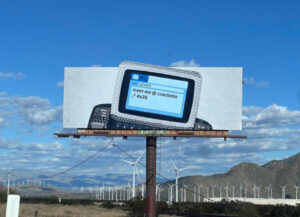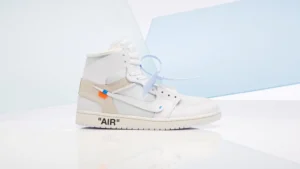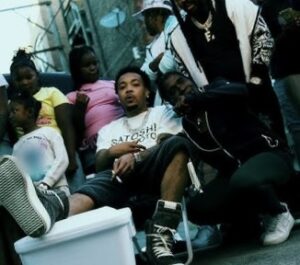
In the weeks leading up to Coachella, something peculiar begins to happen across the Californian highways. The desert—already a mirage of spectacle—starts to shimmer with something even more fantastical: billboards. But not just any billboards. These are preemptive declarations, artistic flexes, and personality-fueled provocations that stretch beyond traditional promotion.
As the 2025 edition of Coachella draws near, artists have turned the roads leading to Indio into a curated experience of absurdity, wit, and cult-brand identity.
From Gaga’s cryptic power play to Laufey’s phonetic PSA, this year’s lineup of billboards does more than advertise a set time—it establishes persona, initiates fandom, and manipulates expectation. This is marketing as performance art. A prelude to the show that often says more about the artist than the show itself.
Lady Gaga: A Monster’s Manifesto
Of all the billboards, none embodies controlled chaos like Lady Gaga’s. No name. No image. Just a line: “Welcome to mayhem, dance or die?” accompanied by her signature monster paw. It doesn’t tell you when she’s performing. It doesn’t tell you what to expect. It tells you one thing: Gaga doesn’t need an introduction.
This billboard feels like a thesis statement for the Coachella experience itself—a dare, a decree, and a wink all in one. Gaga’s return to the festival isn’t just a booking. It’s a consecration. And with a teaser like this, she doesn’t need hype cycles. She is the hype.
Clairo: Dream Pop in Lavender Ink
Clairo’s billboard couldn’t be more different, but it’s no less potent. In soft lavender, a calming message reads: “I got charmed at Coachella.” It’s not loud. It’s not trying to be ironic. It’s Clairo in billboard form—gentle, cool, slightly sardonic.
This nod to her recent album Charm is a clever piece of brand world-building. Rather than selling a set, she sells a vibe. Fans already fluent in Clairo’s sound and style will read it like an inside joke. For others, it’s a soft invitation. Charm, after all, doesn’t shout—it seduces.
Laufey: Teaching the World to Say Her Name
Leave it to Laufey, the Icelandic-Chinese jazz-pop wunderkind, to deliver the most direct—and arguably most brilliant—of this year’s billboard arsenal. It reads: “Still struggling with my name? Visit saylaufey.com to learn.” Paired with a selfie that oozes ironic charm, it’s peak self-aware Gen Z branding.
Here’s why it works: Laufey takes a common frustration (name mispronunciation) and turns it into a marketing CTA. But instead of shaming the audience, she invites them in. It’s inclusive, funny, and educational—all while building her digital footprint. This isn’t a flex. It’s a lesson in how to build intimacy through wit.
Tyla: Got Water? Got Us Laughing
Tyla, the South African rising star known for her sticky-sweet hooks and viral dance moves, dropped a billboard that simply asks: “Got water?” It’s a cheeky spin on the iconic “Got Milk?” campaign, with the same chunky serif typeface and dry humor.
In the desert, this is either a hydration reminder or a branding masterstroke—and likely both. Tyla manages to nod to millennial nostalgia while owning a visual identity with just two words. That’s the kind of marketing most artists can’t pull off with a whole trailer of teasers.
Jennie: Cool Confidence in Five Words
Sometimes, less really is more. Case in point: Jennie of BLACKPINK, whose billboard asks: “Have you ever met Jennie?” That’s it. No context. No explanation. Just a question that functions like a mic drop.
What makes it work is Jennie’s icon status. You either know the name, or you’re about to Google it. It’s sleek, it’s enigmatic, and it leans into K-pop’s global mystique. No fanfare, no flash—just the quiet confidence of an artist who knows a name alone is enough.
DJO: Eleven Levels of Meta
DJO (aka Joe Keery, aka Steve from Stranger Things) gets points for dry wit and brand consistency. His billboard reads: “It’s pronounced DJO.” Helpful? Kinda. But mostly it’s a meta jab at the audience’s confusion—and his own oddball persona.
The design—bold black on yellow—is attention-grabbing yet stripped down, a nice mirror to DJO’s psychedelic-meets-awkward stage presence. Like his music, it walks the line between experimental and accessible, between irony and sincerity. A billboard that doesn’t just say “I’m here,” but “I’m weird, and that’s the point.”
Discolines: The Anti-Billboard Billboard
Perhaps the most unhinged, unforgettable billboard of the year belongs to Discolines, the house music project of Thaddeus Rudd. His reads: “Accidentally smoked that s#it now I’m playing Coachella Saturday.”
It looks handwritten. It might be. It’s messy. It’s chaotic. It’s absurdist genius. In a landscape of polished promos, this billboard throws up its hands and shrugs. It doesn’t care if you know who Discolines is. It doesn’t care if you’re going to see him. It just announces his set the way a stoned friend might text you at 3 AM.
In doing so, it becomes more memorable than any perfect gradient ad could ever hope to be.
Lola Young: Come Get Messy
Last but not least, rising UK star Lola Young drops a perfectly unfiltered callout: “Come get Messy with Lola Young.” It’s part confession, part invitation, and it captures everything about her raspy, emotional songwriting in seven words.
This is branding not as polish but as personality. Lola isn’t promising perfection—she’s promising a good time, a real time. Her billboard is the anti-glamour glamour. And it works because it’s sincere. You don’t want to pose for a selfie in front of this one. You want to dance next to it until your mascara runs.
The Evolution of the Billboard as Festival Teaser
Coachella has long operated as a platform not just for music, but for cultural temperature checks. And nowhere is that more apparent than in the weeks leading up to the festival—when artists begin seeding hype not with singles or press releases, but with giant visual statements planted across the desert.
What used to be simple promotional real estate has become a staging ground for pre-performance identity, a way for artists to assert tone, humor, politics, and persona before stepping on stage. In some ways, these billboards have become the trailer to the movie—telling you not what will happen, but how it will feel.
Humor as a Branding Weapon
What stands out most about the 2025 billboard crop is the sheer range of humor styles. From Gaga’s apocalyptic riddles to Laufey’s educational shade, these artists are using humor not just to amuse, but to self-define.
In an era where parasocial relationships with artists drive fandom, billboards like these don’t just promote—they build trust, forge connection, and convert onlookers into insiders. They say, “I know the joke. You know the joke. We’re in this together.”
The Billboard as Cultural Mirror
More than anything, these signs reflect the shift in how artists view fame. The billboard is no longer a megaphone—it’s a mirror. A place to see not just yourself, but your audience. These signs are performance pieces, artifacts of the cultural moment that will be photographed, memed, TikTok’d, dissected.
In a digital age, the analog charm of the roadside sign has never felt more impactful. It’s physical. It’s immediate. It’s unavoidable. And for one or two weeks before Coachella, it becomes the most important art gallery in America.
Billboard Season Is the New Festival Flow
The desert has always been a stage. But now, the roads leading to that stage are part of the show.
These 2025 Coachella billboards aren’t just clever—they’re necessary. They tell you who the artists are before the lights hit the stage. They make you laugh, think, search, and screenshot. And they raise the bar for what pre-show energy can look like in a post-influencer era.
Coachella isn’t just three days in Indio anymore. It starts weeks earlier—on the side of the road, with a sign, a smirk, and a statement.
No comments yet.









